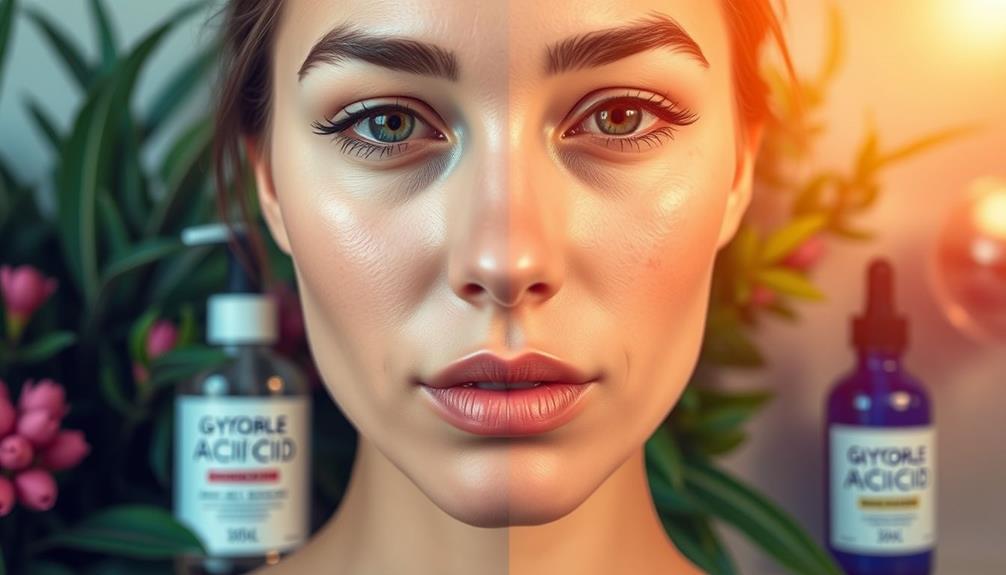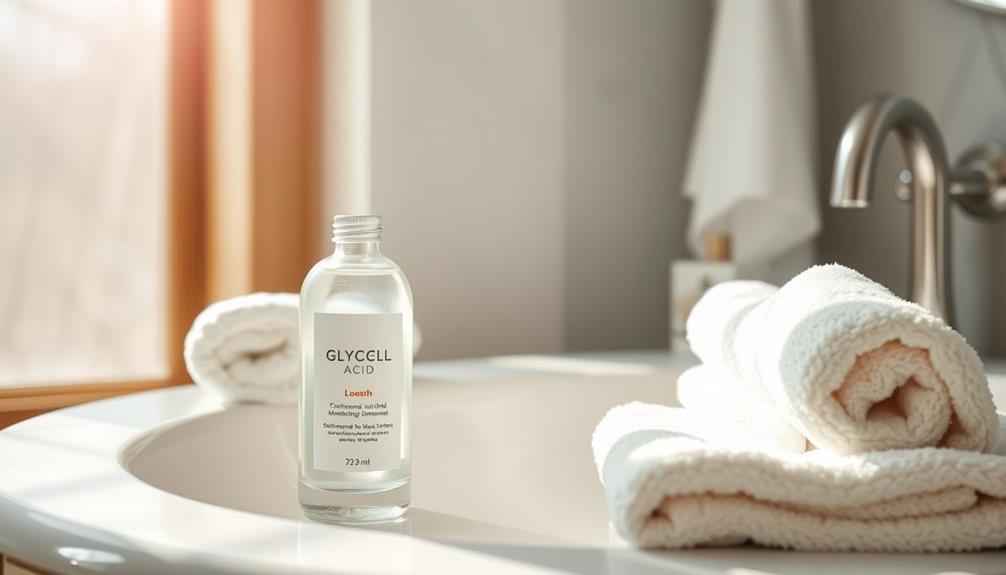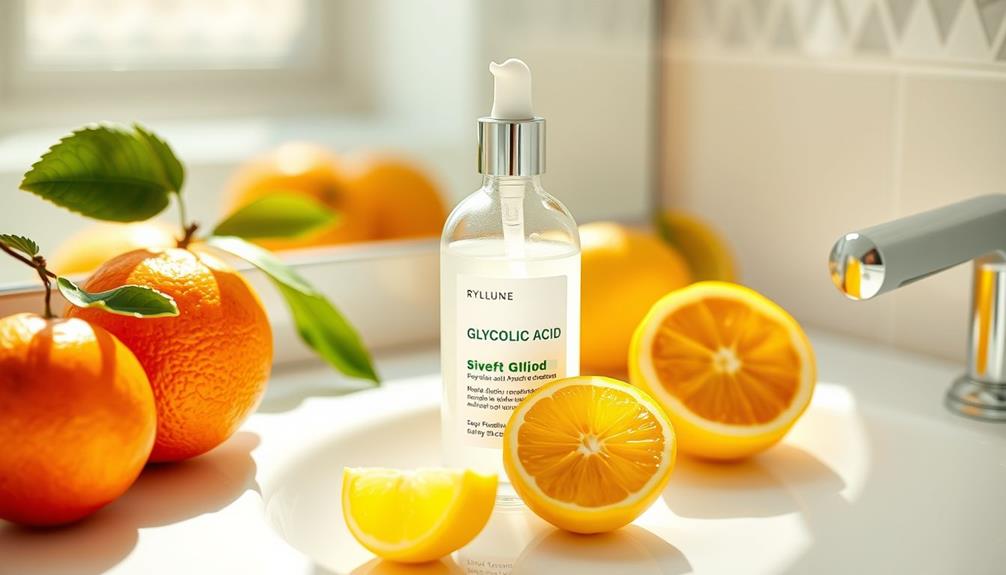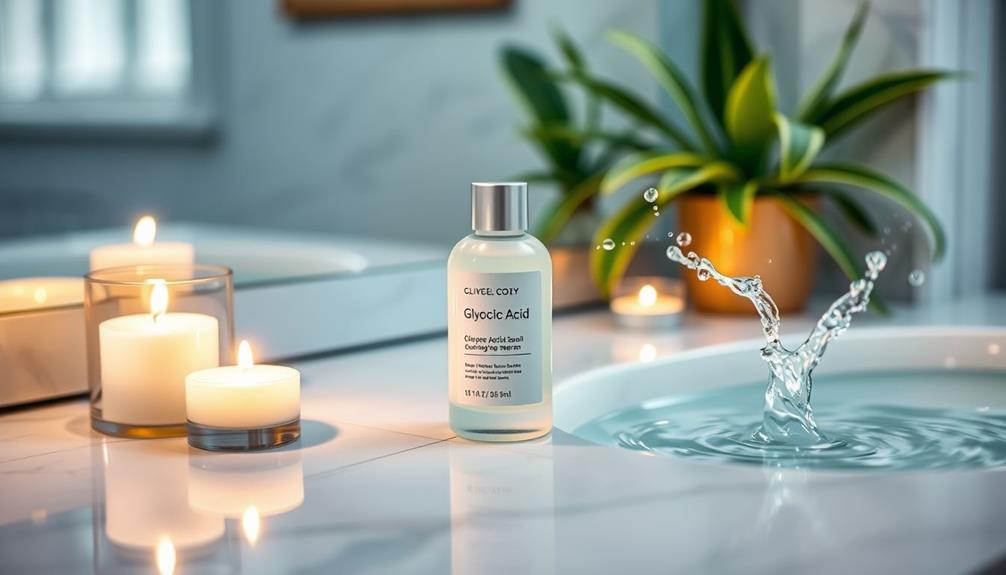Glycolic acid toner has become a must-have for achieving clear skin because it exfoliates effectively, unclogs pores, and helps prevent breakouts. Made from sugar cane, it penetrates deeply to improve skin texture and increase cell turnover. Regular use can enhance radiance, diminish hyperpigmentation, and leave your complexion looking brighter and more even. In addition, it is great for reducing fine lines by boosting collagen production. Start with a lower concentration to see how your skin responds, and always follow up with a hydrating serum or moisturizer. Discover the benefits of adding this potent toner to your skincare routine and experience visible results.
Key Takeaways
- Glycolic acid toner exfoliates skin by dissolving dead skin cell bonds, leading to a smoother and clearer complexion.
- It helps prevent breakouts by reducing pore clogging, making it essential for acne-prone skin.
- Regular use fades hyperpigmentation and age spots, promoting a more even skin tone and brighter appearance.
- Glycolic acid stimulates collagen production, contributing to firmer skin and minimizing fine lines and wrinkles.
Understanding Glycolic Acid

Glycolic acid, a potent alpha-hydroxy acid derived from sugar cane, effectively exfoliates your skin by breaking down the bonds between dead skin cells. This powerful ingredient is known for its ability to enhance skin texture through deep penetration, thanks to its small molecular size.
As you incorporate glycolic acid into your skincare routine, you'll notice improved skin radiance and a more even-toned complexion, primarily due to increased cell turnover. Additionally, incorporating natural remedies like essential oils for skin health can further complement your skincare regimen.
Regular use of glycolic acid stimulates collagen production, which helps to maintain your skin's elasticity and firmness. You can find glycolic acid in various skincare products, such as toners, serums, and peels, typically in over-the-counter concentrations ranging from 5% to 10%.
However, be mindful of the potential for sun sensitivity when using glycolic acid. It's crucial to apply sunscreen daily to protect your skin from UV damage.
Understanding glycolic acid's exfoliation properties equips you with the knowledge to achieve clear skin effectively. With the right approach and consistent use, you'll be on your way to a smoother, healthier complexion.
Key Benefits for Clear Skin

Incorporating a glycolic acid toner into your routine can greatly enhance your skin's clarity and overall health.
The exfoliating properties of glycolic acid work wonders by dissolving the bonds between dead skin cells, leading to a smoother complexion. This process not only reveals fresh skin but also helps reduce pore clogging, which can prevent breakouts.
Additionally, using a glycolic acid toner can be complemented by essential oils for skin benefits, providing a holistic approach to skincare.
Regular use of a glycolic acid toner can fade hyperpigmentation and age spots, promoting a more even skin tone.
As it sloughs off dead skin cells, you'll notice a brighter and clearer appearance. Additionally, glycolic acid stimulates collagen production, contributing to firmer skin and minimizing the appearance of fine lines and wrinkles.
How to Use Glycolic Acid Toner

To achieve the best results with your glycolic acid toner, start by applying it to clean skin using a cotton pad. Gently sweep the pad across your face and neck, avoiding the eye area. If you have sensitive skin, it's essential to perform a patch test before full application. This helps you assess your skin tolerance and prevent any adverse reactions.
Begin incorporating glycolic acid toner into your routine gradually, using it once or twice a week. As your skin adjusts, you can increase the frequency based on your skin's response. For best results, apply the toner at night, as it can increase sun sensitivity.
After applying your glycolic acid toner, follow up with a hydrating serum or moisturizer, especially those enriched with soothing ingredients like hyaluronic acid or ceramides. This helps minimize irritation and supports your skin's hydration.
Here's a quick guide to help you:
| Step | Details |
|---|---|
| 1. Cleanse | Wash your face thoroughly |
| 2. Patch Test | Test a small skin area |
| 3. Apply Toner | Use a cotton pad |
| 4. Moisturize | Apply a hydrating serum or moisturizer |
| 5. Monitor Skin Tolerance | Adjust frequency as needed |
Potential Side Effects

Using glycolic acid toner may lead to potential side effects like redness, irritation, or a tingling sensation, especially if you've got sensitive skin.
These reactions are common and can vary in intensity depending on your skin type and the concentration of glycolic acid in the toner.
For those with darker skin tones, there's an added risk of post-inflammatory hyperpigmentation from irritation, which can result in new dark spots.
Additionally, it's vital to maintain a consistent routine in your skincare, just as you'd with a calming bedtime routine to reduce stress and enhance overall skin health.
Increased sun sensitivity is another significant concern.
When you incorporate glycolic acid into your skincare routine, it's important to apply broad-spectrum sunscreen daily to protect your skin.
Higher concentrations can exacerbate side effects, leading to severe reactions like chemical burns or prolonged irritation, particularly if overused.
To minimize the risk of adverse effects, always perform a patch test before full application.
This simple step helps you gauge your skin's sensitivity to glycolic acid, allowing you to make informed decisions about its use.
Comparing Glycolic Acid With Other Acids

When comparing glycolic acid to other acids, it's essential to understand their unique benefits.
Glycolic acid penetrates deeply for effective exfoliation, often associated with heightened star appeal and attractiveness due to its ability to improve skin texture.
Lactic acid offers a gentler approach, making it ideal for sensitive skin.
On the other hand, salicylic acid targets acne more directly, focusing on oil and debris in your pores.
Glycolic Vs. Lactic Acid
Glycolic acid and lactic acid often get compared because they both offer unique benefits for skin exfoliation and rejuvenation.
Glycolic acid has a smaller molecular size, allowing it to penetrate deeper into the skin for more intensive exfoliation. This makes it particularly effective for oily and acne-prone skin by clearing clogged pores and removing dead skin cells. Additionally, using acids like glycolic can provide a potential tax advantages for those looking to invest in their skincare routine.
On the other hand, lactic acid is gentler, making it more suitable for sensitive or dry skin types.
While both acids promote collagen production, glycolic acid is generally regarded as more potent for enhancing skin texture and stimulating cell turnover.
You'll find glycolic acid concentrations usually range from 5% to 10% in over-the-counter products, whereas lactic acid concentrations tend to be lower, which can be more tolerable for those new to chemical exfoliants.
However, be aware that glycolic acid may increase sun sensitivity, so diligent sun protection is essential when using it.
Lactic acid, with its milder effects, can often be used daily without irritation.
Ultimately, your choice between glycolic and lactic acid depends on your skin type and specific skincare goals.
Glycolic Vs. Salicylic Acid
Understanding the differences between glycolic acid and salicylic acid can help you choose the right exfoliant for your specific skin concerns.
Glycolic acid, an alpha-hydroxy acid (AHA), excels at exfoliating the skin's surface, making it perfect for improving skin texture, reducing fine lines, and brightening your complexion. It works by sloughing off dead skin cells, enhancing the absorption of other skincare products for better skin rejuvenation. Additionally, regular use of exfoliating treatments can promote a more radiant appearance, much like how professional treatments for damaged hair can restore hair health.
On the other hand, salicylic acid is a beta-hydroxy acid (BHA) that penetrates deeper into pores, effectively addressing acne, blackheads, and excess oil production. If you have oily skin, salicylic acid might be your go-to, as it dissolves oil and debris that can lead to breakouts.
Both acids can be beneficial, but they serve different purposes. Glycolic acid is ideal for surface-level exfoliating and overall skin improvement, while salicylic acid targets deep-seated impurities.
If you're considering incorporating these acids into your routine, be cautious, as overuse can lead to irritation or dryness. Choose based on your skin's needs for best results.
Recommended Products

When choosing a glycolic acid toner, it's crucial to evaluate key ingredients and how they address your specific skin concerns.
You'll want to apply these products correctly to maximize their benefits and improve your skin texture.
Let's explore some recommended options that can help you achieve clearer, healthier skin.
Key Ingredients Overview
Key ingredients in glycolic acid toners, such as soothing agents like Aloe Barbadensis Leaf Water and Rosa Damascena Flower Water, help enhance hydration while minimizing irritation.
Glycolic acid, the primary active ingredient, typically comes in concentrations of 5% to 10%, making it effective for exfoliation and improving skin texture. This ingredient promotes cell turnover, allowing your skin to shed dead cells and reveal a fresher layer underneath.
One standout product is The Ordinary Glycolic Acid 7% Toning Solution. It's well-loved for its affordability and effectiveness in reducing acne and hyperpigmentation, giving your skin a noticeable boost in radiance. Regular use can help you achieve clearer skin by improving the absorption of subsequent skincare products, maximizing their efficacy.
Incorporating glycolic acid toners into your routine can lead to significant improvements in skin clarity and texture over time. By managing issues like acne and hyperpigmentation, you can enjoy a smoother, more even complexion.
With the added benefits of hydration from soothing agents, these toners are essential tools for anyone looking to enhance their skincare regimen.
Application Techniques Explained
To effectively apply glycolic acid toner, use a cotton pad to sweep the product across your skin, concentrating on areas that need extra attention.
Start with a low concentration glycolic acid toner, around 5-7%, to assess your skin tolerance. It's essential to perform a patch test on a small area first, especially if you have sensitive skin, to gauge any potential irritation.
Apply the toner in the evening to minimize sun sensitivity.
After the toner has dried, follow up with a hydrating serum to soothe and nourish your skin, then seal it in with a moisturizer.
This combination not only enhances your skin's hydration but also promotes clearer skin through effective exfoliation.
Target Skin Concerns
Addressing specific skin concerns is easier with the right glycolic acid toner, as these products can target issues like acne, hyperpigmentation, and uneven texture effectively.
Glycolic acid promotes gentle exfoliation and boosts cell turnover, helping to minimize blackheads and enlarged pores. This leads to a smoother complexion and clearer skin over time.
One standout option is The Ordinary Glycolic Acid 7% Toning Solution, known for its affordability at under £11.50 for 240ml. By incorporating this toner into your skincare routine, you can experience noticeable improvements in skin clarity and brightness within just a few days of regular use.
As glycolic acid enhances the effectiveness of other treatments, it prepares your skin for better ingredient absorption, making your entire routine more effective.
Whether you're dealing with stubborn acne or tackling hyperpigmentation, a glycolic acid toner can be a game-changer.
Don't underestimate the power of consistent use; it's a simple way to address multiple skin concerns while promoting a radiant, smooth complexion.
Make it a staple in your daily regimen and watch your skin transform!
Building a Skincare Routine

Building a skincare routine involves selecting the right products that work together to enhance your skin's health and appearance. One essential product to take into account is a glycolic acid toner, which acts as an exfoliant, promoting cell turnover and improving your skin's texture.
Start with a lower concentration, around 5%, to avoid irritation and gradually increase usage as your skin adjusts.
Incorporating hydrating ingredients, like hyaluronic acid or ceramides, is vital for maintaining hydration and supporting your skin barrier. This combination helps mitigate any potential dryness from the glycolic acid toner.
To guarantee your routine remains effective, think about alternating active ingredients. For instance, you might use glycolic acid on one night and salicylic acid on another. This approach prevents over-exfoliation, promotes skin tolerance, and keeps your routine dynamic.
Frequently Asked Questions
Does Glycolic Acid Make Your Skin Clear?
Yes, glycolic acid can make your skin clear. It exfoliates dead skin cells, prevents clogged pores, and improves texture. Regular use promotes a smoother complexion while helping to manage breakouts and enhance overall skin tone.
Why Is Glycolic Acid Toner Good for Skin?
Think of glycolic acid toner as a gentle breeze, sweeping away dead skin. It brightens your complexion, smooths texture, and helps other products sink in better, leaving you with clearer, healthier-looking skin you'll love.
Why Is Glycolic Acid Important for Skin?
Glycolic acid's important for your skin because it exfoliates, boosts collagen, and enhances hydration. It effectively reduces blemishes and improves texture, leaving you with a smoother, more radiant complexion that looks youthful and vibrant.
What Happens if You Use Glycolic Acid Toner Everyday?
Using glycolic acid toner daily can feel like a rejuvenating tide washing over your skin, revealing smoothness and radiance. However, be cautious; overuse may lead to irritation, sun sensitivity, and disrupted skin barrier health.
Conclusion
Incorporating a glycolic acid toner into your skincare routine can work wonders for achieving clear skin.
Did you know that 70% of users report noticeable skin improvements within just four weeks?
By exfoliating dead skin cells and promoting cell turnover, glycolic acid helps reveal a fresh, radiant complexion.
Just remember to start slow and listen to your skin.
Make this powerhouse toner a staple, and you'll be well on your way to enjoying the clear skin you desire!










